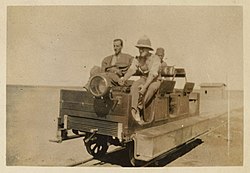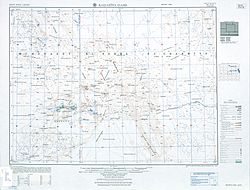Baharia Military Railway
| Baharia Military Railway | |||||||||||||||||||||||||||||||||||||||||||||||||||||
|---|---|---|---|---|---|---|---|---|---|---|---|---|---|---|---|---|---|---|---|---|---|---|---|---|---|---|---|---|---|---|---|---|---|---|---|---|---|---|---|---|---|---|---|---|---|---|---|---|---|---|---|---|---|
|
Draisine in front of the blockhouse B2
| |||||||||||||||||||||||||||||||||||||||||||||||||||||
|
Bahariyya Oasis and the end of the narrow-gauge line
on a map from 1955 | |||||||||||||||||||||||||||||||||||||||||||||||||||||
| Route length: | 134 km | ||||||||||||||||||||||||||||||||||||||||||||||||||||
| Gauge : | 2 feet 6 inches = 762 mm | ||||||||||||||||||||||||||||||||||||||||||||||||||||
| Maximum slope : | 10 ‰ | ||||||||||||||||||||||||||||||||||||||||||||||||||||
|
|||||||||||||||||||||||||||||||||||||||||||||||||||||
The Baharia Military Railway was a 134 km long narrow-gauge railway with a gauge of 762 mm (2 feet 6 inches ) in Egypt that ran from the Nile Valley to the Abu Muharriq shifting dunes near the Bahariyya Oasis.
route
In February 1916 the Sanusi occupied the oases of Bahariyya, Farafra , Dachla and Charga in the western desert of Egypt militarily and from there they pressed the Nile valley . The Western Oasis Railway was successfully used by British troops to retake the Kharga oasis and to supply the garrison there with supplies. From there the British were able to keep the southern Nile valley under control. In order to gain access to the Nile Valley from the north via the Baharia Oasis, the British Army ordered the construction of a new narrow-gauge railway line from Bahnassa station near Samalut in the Nile Valley to the Baharia Oasis on April 15, 1916 . Most of the route followed the Darb-el-Rubi camel trail. To keep the traffic on the camel path under control, six fortified log houses were built.
Assuming that 800 Sanusi occupied the oasis, 2,500 soldiers, 40 motor vehicles and no fewer than 4,800 camels were provided to recapture the oasis. The railway was already used during the construction period to transport building materials, troops, supplies, camel fodder and water, and for supplies. In order to get building material quickly, existing rails and sleepers from lines of other Egyptian narrow-gauge railways were dismantled and reused.
The Sanusi withdrew to the Siwa Oasis on October 10, 1916 , when they realized that an attack was imminent. A week later, on October 16, 1916, camel riders and motor vehicle troops recaptured the oasis. Another week later, the 134 km long line was completed on October 23, 1916. On average, 700 m of track was laid per day within 191 days. Because of the Abu Muharriq shifting dunes, it was impossible to extend the railroad beyond the B6 blockhouse, so the route ended there.
After the Sanusi no longer posed any danger, the British troops withdrew from January 1917. From March 1917, the block houses B1-B5 were dismantled because they were no longer needed. The military railroad was still in operation to transport food, feed, water, motor vehicles, fuel and other supplies to the terminus at blockhouse B6. From there they were brought to the garrison in the oasis by camel caravans or by truck. Up to 20 locomotives and 200 wagons were used on the route. After the war ended in 1918, the military saw no need to continue operating the line, despite the rich phosphate and iron ore deposits nearby. Therefore it was shut down in 1919.
Individual evidence
- ^ A b c Iain Logie: Light railways of the Egyptian Expeditionary Force 1915-18 (Part 3: The railways of the Western Desert). In: The Narrow Gauge , issue 240.
- ^ A b c Iain Logie: Egyptian Narrow Gauge Railways - Their History and Stock. Research Notes V2. August 2017.



